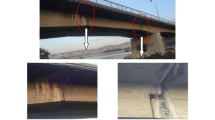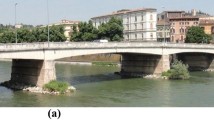Abstract
In this paper, modal parameters of the Eynel steel arch highway bridge are identified and the fatigue behavior of the bridge is investigated. Modal parameters were extracted from three ambient vibration tests carried out over the period since the bridge came into service. The bridge became operational in 2009, and experimental measurements were taken in 2010, 2019, and 2021. The Enhanced Frequency Domain Decomposition (EFDD) method in the frequency domain and the Stochastic Subspace Identification (SSI) method in the time domain were used. Modal parameters were compared and any differences found over time in the measurement test results were investigated. Comparison of the results shows that changes in the natural frequencies were very limited and there was no change between the mode shapes. When experimental natural frequencies were compared, the maximum difference between the first and second measurements was calculated as 2.827%. Similarly, the maximum difference between the first and third measurements was 5.587% for the second mode, and around 3% for the other modes. This result is as expected because: (i) the bridge is not subject to heavy vehicle traffic and only connects village roads; (ii) no significant earthquake occurred during this period in the region which might have caused structural damage; (iii) no corrosion was found in the structural system elements as there was no contact with the reservoir water; (iv) no settlement or sliding occurred in the ground and boundary conditions remained unchanged. Moreover, the fatigue behavior of the bridge was investigated using the stress life method and AASHTO LRFD Bridge Design Specifications. To rationalize the results against the fatigue effects, the verified finite element model was used. From the fatigue analyses, it was concluded that the fatigue life of the bridge was within safe limits.
















Similar content being viewed by others
References
Adanur S, Altunışık AC, Başağa HB, Soyluk K, Dumanoğlu AA (2017) Wave-passage effect on the seismic response of suspension bridges considering local soil conditions. Int J Steel Struct 17(2):501–513
Alamdari MM, Rakotoarivelo T, Khoa NLD (2017) A spectral-based clustering for structural health monitoring of the Sydney Harbour Bridge. Mech Syst Signal Process 87:384–400
Altunışık AC, Bayraktar A, Sevim B, Ateş Ş (2011) Ambient vibration based seismic evaluation of isolated Gülburnu highway bridge. Soil Dyn Earthq Eng 31(11):1496–1510
Altunışık AC, Bayraktar A, Sevim B, Özdemir H (2011) Experimental and analytical system identification of Eynel arch type steel highway bridge. J Constr Steel Res 67(12):1912–1921
Altunisik AC, Bayraktar A, Ozdemir H (2012) Seismic safety assessment of eynel highway steel bridge using ambient vibration measurements. Smart Struct Syst 10(2):131–154
Altunisik AC, Kalkan E (2016) Investigation of earthquake angle effect on the seismic performance of steel bridges. Steel Compos Struct 22(4):855–874
Altunışık AC, Okur FY, Kahya V (2017) Modal parameter identification and vibration based damage detection of a multiple cracked cantilever beam. Eng Fail Anal 79:154–170
American Society of Civil Engineers ASCE Library (1982) Fatigue reliability: variable amplitude loading, by committee on fatigue and fracture reliability of the committee on structural safety and reliability of the structural division. J Struct Div 108:47–69
AASHTO (2012) AASHTO LRFD Bridge Design Specifications, 6th edn. American Association of State Highway and Transportation Officials, Washington, DC
Apaydın NM, Kaya Y, Şafak E, Alçık H (2012) Vibration characteristics of a suspension bridge under traffic and no traffic conditions. Earthquake Eng Struct Dynam 41(12):1717–1723
Bayraktar A, Altunişik AC, Sevim B, Özşahin TŞ (2014) Environmental effects on the dynamic characteristics of the Gülburnu Highway Bridge. Civ Eng Environ Syst 31(4):347–366
Bendat JS, Piersol AG (2004) Random data: analysis and measurement procedures, 3rd edn. John Wiley and Sons, USA
Brincker R, Zhang L, Andersen P (2000) Modal identification from ambient responses using frequency domain decomposition. In Proc. of the 18th International Modal Analysis Conference (IMAC), February, San Antonio, Texas
Cantieni R (2005) Experimental methods used in system identification of civil engineering structures. In Proceedings of the International Operational Modal Analysis Conference (IOMAC), pp 249–260
Casas JR, Moughty JJ (2017) Bridge damage detection based on vibration data: past and new developments. Front Built Environ 3:4
Chang M, Pakzad SN (2014) Optimal sensor placement for modal identification of bridge systems considering number of sensing nodes. J Bridge Eng 19(6):04014019
Cornwell P, Farrar CR, Doebling SW, Sohn H (1999) Environmental variability of modal properties. Exp Tech 23(6):45–48
Cheynet E, Snæbjörnsson J, Jakobsen JB (2017) Temperature effects on the modal properties of a suspension bridge. Dynamics of Civil Structures, 2. Springer, Cham, pp 87–93
Ding Y, Li A, Liu T (2008) Environmental variability study on the measured responses of Runyang Cablestayed Bridge using wavelet packet analysis. Sci China Ser E: Technol Sci 51(5):517–528
Ding Y, Li A (2011) Temperature-induced variations of measured modal frequencies of steel box girder for a long-span suspension bridge. Int J Steel Struct 11(2):145–155
Ewins DJ (1984) Modal testing: theory and practice. Research Studies Press, New York, Letchworth, Hertfordshire, England
Genç AF, Ergün M, Günaydin M, Altunişik AC, Ateş Ş, Okur FY, Mosallam AS (2019) Dynamic analyses of experimentally-updated FE model of historical masonry clock towers using site-specific seismic characteristics and scaling parameters according to the 2018 Turkey building earthquake code. Eng Fail Anal 105:402–426
Günaydin M, Adanur S, Altunişik AC, Sevım B, Bayraktar A (2017) Finite modeling updating effects on the dynamic response of building models. J Test Eval 45(5):1630–1649
Günaydin M (2019) Seismic performance evaluation of a fire-exposed historical structure using an updated finite element model. Eng Fail Anal 106:104149
Hacıefendioğlu K, Başağa HB, Bayraktar A, Ateş Ş (2007) Nonlinear analysis of rock-fill dams to non-stationary excitation by the stochastic Wilson-θ method. Appl Math Comput 194(2):333–345
Hacıefendioğlu K, Maraş EE (2016) Photogrammetry in documentation and ambient vibration test of historical masonry minarets. Exp Tech 40(6):1527–1537
He H, Wang W, Zhang X (2019) Frequency modification of continuous beam bridge based on co-integration analysis considering the effect of temperature and humidity. Struct Health Monit 18(2):376–389
Heo G, Wang ML, Satpathi D (1997) Optimal transducer placement for health monitoring of long span bridge. Soil Dyn Earthq Eng 16:495–502
Huang JZ, Li DS, Li HN, Song GB, Liang Y (2018) Damage identification of a large cable-stayed bridge with novel cointegrated Kalman filter method under changing environments. Struct Control Health Monit 25(5):e2152
Jacobsen NJ, Andersen P, Brincker R (2006) Using enhanced frequency domain decomposition as a robust technique to harmonic excitation in operational modal analysis. In Proc. of ISMA2006: International Conference on Noise & Vibration Engineering, September, Leuven, Belgium
Josi G (2010) Reliability-based management of fatigue failures, Thesis (PhD), University of Alberta, Canada
Jung BK, Cho JR, Jeong WB (2015) Sensor placement optimization for structural modal identification of flexible structures using genetic algorithm. J Mech Sci Technol 29(7):2775–2783
KGM (2017) Köprü Envanter Bilgileri, T.C. Ulaştırma Denizcilik ve Haberleşme Bakanlığı, Karayolları Genel Müdürlüğü, Köprü ve Tünel Bilgileri
Kim TH, Lee KM, Chung YS, Shin HM (2005) Seismic damage assessment of reinforced concrete bridge columns. Eng Struct 27(4):576–592
Li H, Li S, Ou J, Li H (2010) Modal identification of bridges under varying environmental conditions: temperature and wind effects. Struct Control Health Monit 17:495–512
Liang Y, Li D, Song G, Feng Q (2018) Frequency Co-integration-based damage detection for bridges under the influence of environmental temperature variation. Measurement 125:163–175
Moser P, Moaveni B (2011) Environmental effects on the identified natural frequencies of the Dowling Hall Footbridge. Mech Syst Signal Process 25(7):2336–2357
NBI (2016a) Deficient Bridges by Superstructure Material, U.S. Department of Transportation Federal Highway Administration, Bridges & Structures
NBI (2016b) Deficient Bridges by Year Built, U.S. Department of Transportation Federal Highway Administration, Bridges & Structures
Ni YQ, Hua XG, Fan KQ, Ko JM (2005) Correlating modal properties with temperature using long-term monitoring data and support vector machine technique. Eng Struct 27(12):1762–1773
Ni YQ, Ko JM, Hua XG, Zhou HF (2007) Variability of measured modal frequencies of a cable-stayed bridge under different wind conditions. Smart Struct Syst 3(3):341–356
Oehme P (1989) Schäden an stahltragwerken–eine analyse (Damage analysis of steel structures), IABSE Proceedings P139/89
OMA (2006) Release 4.0. Computer Software. Structural Vibration Solution, Aalborg, Denmark
Park YJ, Ang AH, Wen YK (1987) Damage-limiting aseismic design of buildings. Earthq Spectra 3(1):1–26
Peeters B (2000) System identification and damage detection in civil engineering. PhD Thesis, Leuven, Belgium
Peeters B, De Roeck G (1999) Reference based stochastic subspace identification in civil engineering. In Proceedings of the 2nd International Conference on Identification in Engineering Systems, Swansea, UK, March 1, pp 639–648
Peeters B, De Roeck G (2001) One-year monitoring of the Z24-Bridge: environmental effects versus damage events. Earthquake Eng Struct Dynam 30(2):149–171
Prokon (2007) Prokon Engineering and Consultancy Inc., Ankara, Turkey
PULSE (2006) Release 11.2, Computer Software, Bruel and Kjaer, Nærum, Denmark
Rao ARM, Anandakumar G (2008) Optimal sensor placement techniques for system identification and health monitoring of civil structures. Smart Struct Syst 4(4):465–492
Rodriguez-Gomez S, Cakmak AS (1990) Evaluation of seismic damage indices for reinforced concrete structures. Report No NCEER 90–0022, National Center for Earthquake Engineering Research, State University of New York at Buffalo
SAP2000 (2015) Structural Analysis Program, Computers and Structures Inc., Version: 17.1.1, Berkeley, California, USA
Sen D, Erazo K, Zhang W, Nagarajaiah S, Sun L (2019) On the effectiveness of principal component analysis for decoupling structural damage and environmental effects in bridge structures. J Sound Vib 457:280–298
Siringoringo DM, Fujino Y (2006) Observed dynamic performance of the Yokohama-Bay Bridge from system identification using seismic records. Struct Control Health Monit 13(1):226–244
Sony S, Laventure S, Sadhu A (2019) A literature review of next-generation smart sensing technology in structural health monitoring. Struct Control Health Monit 26(3):e2321
Stone WC, Taylor AW (1993) Seismic performance of circular bridge column designed in accordance with AASHTO/CALTRANS standards. NIST Building Science Series, vol. 170. Gaithersburg (MD): National Institute of Standards and Technology
Sun L, Shang Z, Xia Y, Bhowmick S, Nagarajaiah S (2020) Review of bridge structural health monitoring aided by big data and artificial intelligence: from condition assessment to damage detection. J Struct Eng 146(5):04020073
Wahab MA, De Roeck G (1997) Effect of temperature on dynamic system parameters of a highway bridge. Struct Eng Int 7(4):266–270
Wang H, Mao JX, Xu ZD (2020) Investigation of dynamic properties of a long-span cable-stayed bridge during typhoon events based on structural health monitoring. J Wind Eng Ind Aerodyn 201:104172
Williams MS, Villemure I, Sexsmith RG (1997) Evaluation of seismic damage indices for concrete elements loaded in combined shear and flexure. ACI Struct J 94(3):315–322
Yang YB, Xu H, Zhang B, Xiong F, Wang ZL (2020) Measuring bridge frequencies by a test vehicle in non-moving and moving states. Eng Struct 203:109859
Yu DJ, Ren WX (2005) EMD-based stochastic subspace identification of structures from operational vibration measurements. Eng Struct 27(12):1741–1751
Zhao Y (2003) Fatigue prone steel bridge details. Investigation and recommended repairs, Thesis (PhD), University of Kansas, ABD
Zhou HF, Ni YQ, Ko JM, Wong KY (2008) Modeling of wind and temperature effects on modal frequencies and analysis of relative strength of effect. Wind Struct 11(1):35–50
Zhou Y, Sun L (2019) Effects of environmental and operational actions on the modal frequency variations of a sea-crossing bridge: a periodicity perspective. Mech Syst Signal Process 131:505–523
Živanović S, Pavic A, Reynolds P (2006) Modal testing and FE model tuning of a lively footbridge structure. Eng Struct 28(6):857–868
Acknowledgements
The author would like to thank Res. Asst. Olguhan Şevket Karahasan and Res. Asst. Muhammet Sarı for their assistance throughout the course of the experimental study.
Author information
Authors and Affiliations
Corresponding author
Additional information
Publisher's Note
Springer Nature remains neutral with regard to jurisdictional claims in published maps and institutional affiliations.
Rights and permissions
About this article
Cite this article
Sunca, F., Ergün, M., Altunişik, A.C. et al. Modal identification and fatigue behavior of Eynel steel arch highway bridge with calibrated models. J Civil Struct Health Monit 11, 1337–1354 (2021). https://doi.org/10.1007/s13349-021-00512-w
Received:
Revised:
Accepted:
Published:
Issue Date:
DOI: https://doi.org/10.1007/s13349-021-00512-w




